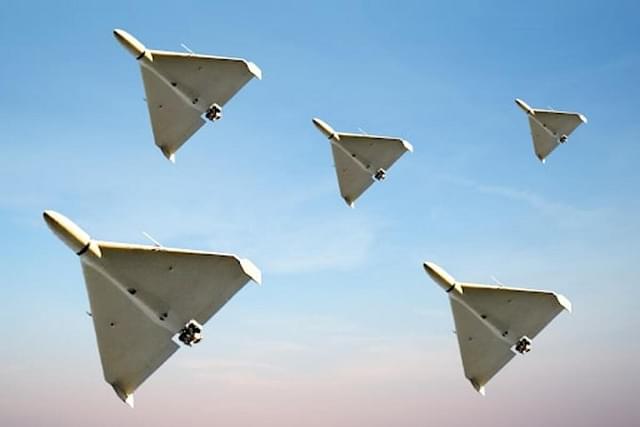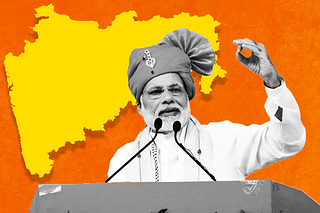Defence
Can India Defend Against A Massed Drone Attack From China Like The One Iran Launched On Israel?
Ujjwal Shrotryia
Apr 15, 2024, 06:09 PM | Updated 06:09 PM IST
Save & read from anywhere!
Bookmark stories for easy access on any device or the Swarajya app.

Two days ago, Israel, with the help of the US, successfully defended against a large missile and drone attack from Iran.
Of the more than 325 projectiles — 185 drones, 110 ballistic missiles, and 30 cruise missiles — fired by Iran, Israel claims that close to 99 per cent were intercepted, with only a few, estimated to be seven, falling at an air force base in Israel causing minor damage.
This raises the question — What if India faced a saturated long-range drone attack by either Pakistan or China?
Can India defend against such a hypothetical massed saturated attack?
Drones — unlike ballistic missiles that follow a ballistic trajectory and fly high in the air, which is detectable by radars — fly at a very low altitude like a slow-moving cruise missile, making them very difficult to detect. Unless the defender has prior information or early warning mechanisms and systems in place, it becomes very difficult to intercept until the drones have come uncomfortably close.
The Israelis had prior warnings that Iran would strike them within the next 24 to 48 hours. This allowed the IDF and its allies to be ready for the attack.
However, knowing the attack will take place is one thing, but having real-time information about the attack is another. The latter allows the defender to place adequate assets in the right quantity at the right place and at the right time.
The Israelis, with the help of their American, British, French, and Arabian allies, had sufficient real-time information about the attack. As soon as the missiles and drones took off from Iranian territory, Israel’s Arabian allies, like the United Arab Emirates, Jordan, and Saudi Arabia, shared accurate radar tracks of the drones with the US and Israel, giving ample time to the Israeli Air Force to be on correct locations to shoot down the drones.
So, in a hypothetical scenario of an attack, India will need adequate early warning of the impending attack. India has long-range Swordfish radars based on the Israeli Greenpine radar for early warning.
However, there is doubt regarding the capability of these radars — which are designed to detect ballistic missiles and fast-flying objects at high altitudes — to detect the launch of small carbon-fibre-made drones flying at very low altitudes.
Airborne Early Warning and Control Systems (AWACS) can detect these drones, but due to the limited number of these assets in the Indian Air Force (IAF) inventory, and even fewer available for operations at any given time, this option is even less likely. It would require prior early warning for India to strategically position these AWACS in the right place.
But, for the argument's sake, let's assume India gets a prior warning of the impending attack.
Then, does India have the capability to shoot these drones from the sky?
Yes, it does. Drones will be intercepted by fighter jets, anti-air artillery (AAA), viz, Bofors 40 mm L-70 and Zu-23-2 guns, some by shoulder-fired air defence missiles like Igla-S, some by newer Akash, SPYDER, and joint Indo-Israeli Medium Range Surface to Air Missile (MRSAM) missiles, and others by soft-kill counter-drone systems.
As and when India inducts newer Quick Reaction Surface to Air Missile (QRSAM), Akash-Prime, and Akash-NG missile systems, they will provide an additional layer of security to the defences.
The numerous older Soviet-origin missile systems like 9K33 Osa, 2K22 Tunguska, and Pechora in the armed forces are not considered due to their poor performance in both the Russia-Ukraine and Armenia-Azerbaijan’s Nagorno-Karabakh conflict.
There have been multiple incidents in both these wars when these systems' older radars failed to detect drones.
The S-400 systems will be used only under exceptional circumstances, and its mention is avoided simply due to the extremely absurd cost-to-benefit ratio of shooting a $10,000 drone with a missile costing millions of dollars, that too available in only limited numbers.
Indian Army’s new Akashteer and IAF’s Integrated Air Command and Control System (IACCS) command and control system might be able to provide an integrated picture of the airspace, but how effective both of these will be in an actual combat scenario remains unanswered.
One has to remember these massed drone attacks will also come with some sort of jamming and electronic warfare component that will try to interfere with the working of both these systems.
Even after shooting down most of these drones, some will eventually escape the defences and will find their targets.
Moreover one has to remember that this could be just the first volley of attack. If the enemy fires ballistic missiles, cruise missiles, and sends their air force simultaneously with the drones, this situation will quickly get even more complicated, shifting the odds in favor of the attacker.
Furthermore, unlike Israel whose total area is no more than a small Indian state, India has to defend large swaths of territory, which is difficult. No country, not even the US, can defend such a complex attack on an area spread thousands of kilometres across.
Now what if, this attack was followed by more of such volleys? would India be able to defend against it?
This entirely depends on, first, the number of interceptors that have been stockpiled in the inventory and the speed at which these can be supplied and reloaded to the launchers, and second, on the ability of the Indian manufacturing ecosystem to surge increase its production capacities of these interceptors.
Even if India is able to defend from some more volleys of attack, time is in the favor of the attacker.
The stockpiles of these complex and costly missiles will eventually run out and will take a long time to restore, in comparison to the stockpiles of cheap drones that can be recovered quickly.
India’s best option in that case is to launch a strike of its own instead of waiting for the enemy to launch further attacks.
The attack and successful defence by Israel is just a trailer to what could be in store for India if it ever goes to war with China.
It is imperative that India increases spending on creating substantial stockpiles and war reserves, inducts more early warning elements and increases production capacities, not only of interceptors but also of long-range missiles that will act as deterrents, compelling the Chinese to think before attempting any such misadventure.
Expediting the establishment of the rocket force would be the first step toward this.
Save & read from anywhere!
Bookmark stories for easy access on any device or the Swarajya app.
Editorial Associate at Swarajya. Writes on Indian Military and Defence.
Introducing ElectionsHQ + 50 Ground Reports Project
The 2024 elections might seem easy to guess, but there are some important questions that shouldn't be missed.
Do freebies still sway voters? Do people prioritise infrastructure when voting? How will Punjab vote?
The answers to these questions provide great insights into where we, as a country, are headed in the years to come.
Swarajya is starting a project with an aim to do 50 solid ground stories and a smart commentary service on WhatsApp, a one-of-a-kind. We'd love your support during this election season.
Click below to contribute.





